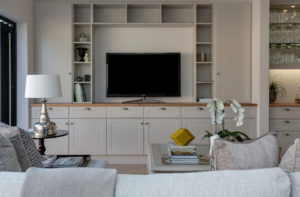
The living room is where most people spend the bulk of their time at home. Yet, despite this, many homeowners feel their living rooms look tired, lack character, or simply aren’t as comfortable as they could be. The common assumption is that transforming a space requires a large budget or weeks of work, but that’s far from the truth.
Small, thoughtful changes can make a surprising difference, often in a single evening. By focusing on details that affect the overall look and feel, you can create a space that feels refreshed, more functional, and better suited to your lifestyle. The key is to know where to put your energy so that each change delivers the most impact without unnecessary effort or cost.
Below are some effective ways to transform your living room overnight. Let’s start with the ones that can instantly shift the mood and style of your space.
Check Comfort and Climate Control
A living room should not only look good but also feel comfortable in every season. If the temperature is inconsistent, or if you notice drafts or stuffy air, it might be worth reviewing your heating and cooling setup. Sometimes, it’s as simple as cleaning vents or adjusting furniture that blocks airflow. Other times, you might decide it’s the right moment to upgrade your air conditioner to improve both comfort and energy efficiency.
Good climate control ensures you enjoy spending time in the living room year-round. This practical step is often overlooked, but it can have just as much impact on your enjoyment of the space as any design change.
Layer Lighting for a Warmer Atmosphere
Many living rooms rely only on one main light source, which often makes the space feel flat or overly bright. Layering your lighting can instantly change that. Combine overhead lighting with floor or table lamps to create a mix of brightness levels.
Warm-toned bulbs help the room feel inviting, especially in the evening. Adjustable lamps or dimmer switches allow you to control the intensity depending on the activity—whether you’re reading, watching TV, or having guests over. The goal is to make the room versatile, so it can shift easily from functional to cozy when needed.
Anchor the Room with a Statement Rug
A rug does more than add softness underfoot; it can define the space and tie the whole design together. Choosing a rug with a bold pattern or a strong color can instantly make the room feel more intentional.
Size matters here—too small and it will look disconnected from the rest of the furniture. Ideally, the rug should be large enough so that at least the front legs of your main seating pieces sit on it. If you prefer something more subtle, choose a neutral tone with an interesting texture to add visual interest without overpowering the room.
Add Freshness with Greenery
Plants bring an instant sense of life and freshness into a living room. They can soften hard edges, fill empty corners, and improve the air quality. Even one or two well-placed plants can make a noticeable difference.
For low-maintenance options, consider snake plants, pothos, or peace lilies. These require little care but still thrive indoors. Place plants near natural light sources and use decorative pots that match your room’s style. If real plants aren’t practical for you, high-quality faux plants can still add greenery without the upkeep.
Update Your Wall Art for Instant Impact
Wall art often sets the tone for a room, but many people leave the same pieces hanging for years without change. Updating what’s on your walls can make the living room feel fresh and more reflective of your style today. You don’t have to invest in expensive works—affordable prints, framed photographs, or even DIY artwork can make a big difference.
Rotating art seasonally can keep your space interesting. For example, brighter colors or nature themes work well in spring and summer, while richer tones and abstract patterns suit the cooler months. If you want to create a focal point, consider a large statement piece or a simple gallery wall. The goal is to choose pieces that complement your furniture and color scheme without overwhelming the space.
Style Your Coffee Table with Purpose
A coffee table can either look like a dumping ground for clutter or a curated part of your décor. Styling it with intention makes the whole room feel more polished. Use a combination of functional and decorative items—such as a tray to hold remotes, a stack of books for interest, and a small vase of flowers for color.
Keeping items grouped together helps the table look tidy while still being practical. Avoid overcrowding; leaving open space makes the arrangement feel balanced and allows you to use the table without constantly moving things around. This is one of those quick changes that costs little but delivers a clear visual improvement.
Refresh Soft Furnishings for a Cohesive Look
Soft furnishings like curtains, slipcovers, or even cushion covers have a big influence on a living room’s style. Worn or outdated fabrics can make the space feel less inviting, while fresh ones can tie the whole design together.
When updating curtains, choose a length that reaches the floor for a more finished look. If you have older furniture that’s still comfortable but looks dated, a well-fitted slipcover can transform it without the expense of replacement. Matching these fabrics to other elements in the room, such as rugs or pillows, creates a cohesive feel that makes the space look professionally put together.
Reposition and Rotate Decorative Accessories
Decorative items like vases, sculptures, or framed photos can lose their visual impact if they’ve been in the same place for years. Moving them to new spots or swapping them with items from another room can make everything feel new.
When displaying accessories, grouping items in odd numbers often works better visually. Combine different heights and textures for more interest. You don’t need to buy anything new; often, just changing the arrangement makes you notice and appreciate pieces you already own. This simple approach can completely change the way a shelf, mantel, or side table looks in minutes.
Transforming your living room doesn’t have to involve major renovations or a large budget. By making small, deliberate updates, you can create a space that feels more inviting, functional, and reflective of your style. Whether you’re swapping textiles, introducing plants, updating art, or fine-tuning comfort, each change adds value in its own way.
The key is to focus on what will make the biggest difference to how the room looks and feels today. Even just a few of these ideas can refresh the space and make it more enjoyable for you and your guests, all without weeks of work or heavy spending.






